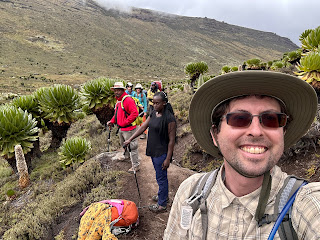On Friday morning, we rose early to begin our journey to the next camp. After a late breakfast and plenty of water and tea, we packed up our bags and set out up the mountain. For the first 1000 feet or so vegetation continued to resemble chaparral, and the slope was so gentle the immensity of the mountain was hidden from us, it looked like our destination was just around the corner. We passed by a couple crystal clear mountain springs brimming with lush vegetation as we continued to weave up and down the mountain valleys. Gradually the ground grew wetter and more boggy as we entered the Afro-Montane moorland in transition to the higher subalpine zones.
 |
| Peaks of Mt. Kenya |
 |
| Subalpine Chaparral |
 |
| Pristine mountain stream |
 |
|
After a quick stop for a break by one of the mountain streams, we ascended a particularly tall hill, and entered Mackinder valley where we encountered a dramatic change in the vegetation. At this point we had reached around 12,000 feet in elevation, where one encounters a vegetation band that is unique to mount Kenya. In this area several species of giant Groundsel and giant Lobelia grow that are uniquely adapted to this ecosystem. A Groundsel is essentially a dandelion, but these groundsels are enormous, the size of trees, and look more like agave plants than dandelions. They have unique adaptations that allow them to live in the rapid temperature changes found at Mt. Kenya such as a protective layer of dead leaves on their stem, secretion of an ice nucleating polysaccharide that acts as a natural antifreeze, and giant leaves that allow them to store water. The giant Lobelias are big, fuzzy dudes with purple flowers that provide a home to various species of birds and exhibit similar adaptations for extreme dry and cold. The presence of these otherworldly plants lended the valley a positively Mesozoic atmosphere. It was like we had stepped into another time, another planet.
 |
| The wet, wide and wild Mackinder Valley |
 |
Giant Groundsel (genus Dendrosenecio)
|




 |
| Giant Lobelia (Lobelia Telekii) |
After a couple hours of trekking through this marvelous landscape, we took a Paleozoic pause for lunch by a stream in a particularly scenic grove of giant herbs. Lunch was simple: ramen noodles, and vegetables, but it hit the spot so well in the cold wet valley. During our lunch we were continually approached by tiny, cute little brown birds, with the most delightful round shapes, and a fearless attitude towards begging for food. We refilled our water, and then moved on.
 |
| Prehistoric lunch spot |
After lunch, we trekked more toward the upper reaches of the Mackinder Valley, which opened up into a widened U-shape indicating its likely glacial origin. Mount Kenya used to be covered in glaciers, but now they are only few and tiny. Since I have moved to Washington, I have become aware of the effects of glaciers on mountain landscapes, and has become attuned to spotting features such as tarns, cirques, aretes, and other signs that slow, grinding walls of ice have played a role in the formation of the landscape. At this point, we had passed 13,000 feet, and this was when the altitude sickness set in. Like clockwork, I developed a headache and extreme fatigue. On the advice of Rochelle and Natalia, I took some ibuprofen, which helped immensely, for a while. With my symptoms managed, we ascended the final hill and entered Shipton's camp, elevation 13,800 feet. From here we had a tantalizing view of the peaks that we would be encountering tomorrow, in my case, and the day, after in a case of Natalya and Rochelle.
 |
| More plant pics |
 |
| Happy trekkers |
 |
| Malachite Sunbird |
 |
| Misty valley |
 |
| A well fed hyrax |
 |
| Rugged peaks |
 |
| Reaching Shipton's Camp |
At this point, the elevation was starting to seriously affect me; I was medicating myself regularly with ibuprofen and gladly took the Diamox that Rochelle offered me (thank you! You are a lifesaver!). My appetite was reduced as well, but I managed to have a snack of popcorn, provided by our chefs, and have a simple dinner of lentils and vegetable curry. While sitting around, trying not to be too miserable, I struck up a conversation with a Swedish fellow, who was sitting across from me. Patrick, from Gothenburg, was here in Kenya on vacation with his friend to go cycling through the bush. So far he had covered a lot of the rift valley, including Naivasha. He remarked that the cycling here is excellent, and the gravel roads are ideal for the type of cycling he does. Patrick is a manager at a golf course, which is closed during the harsh Swedish winter, so Patrick has a month and a half long vacation every northern hemisphere winter. He takes that opportunity to travel someplace warm (he doesn't care for winter sports!), usually on a cycling vacation. His traveling companion, unfortunately, had taken ill with altitude sickness, so he would be ascending alone tomorrow morning. After some more chitchatting, it was time to retire early because Philip and I would wake up at 2:15 AM to begin the ascent of Mount Kenya at 3 AM..

















No comments:
Post a Comment